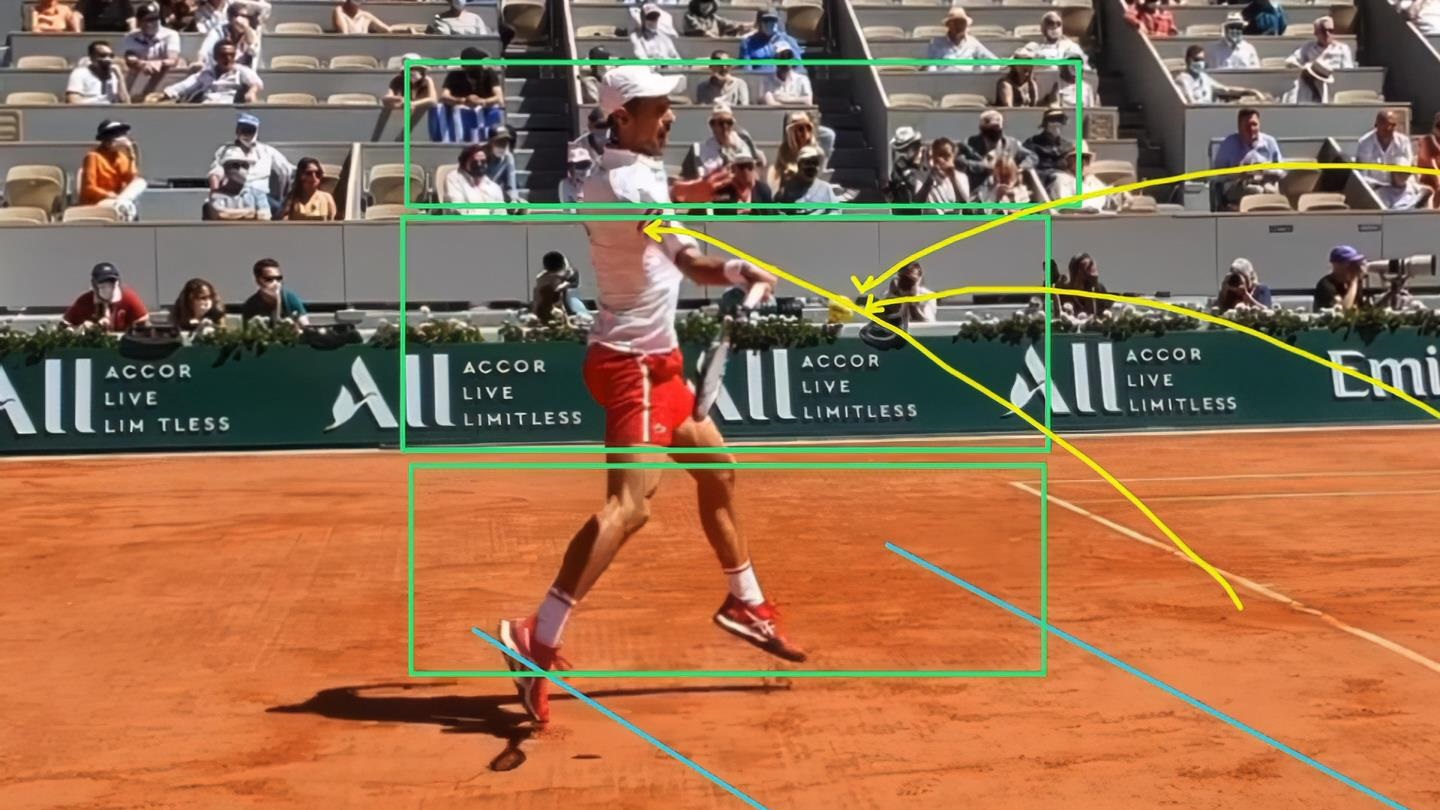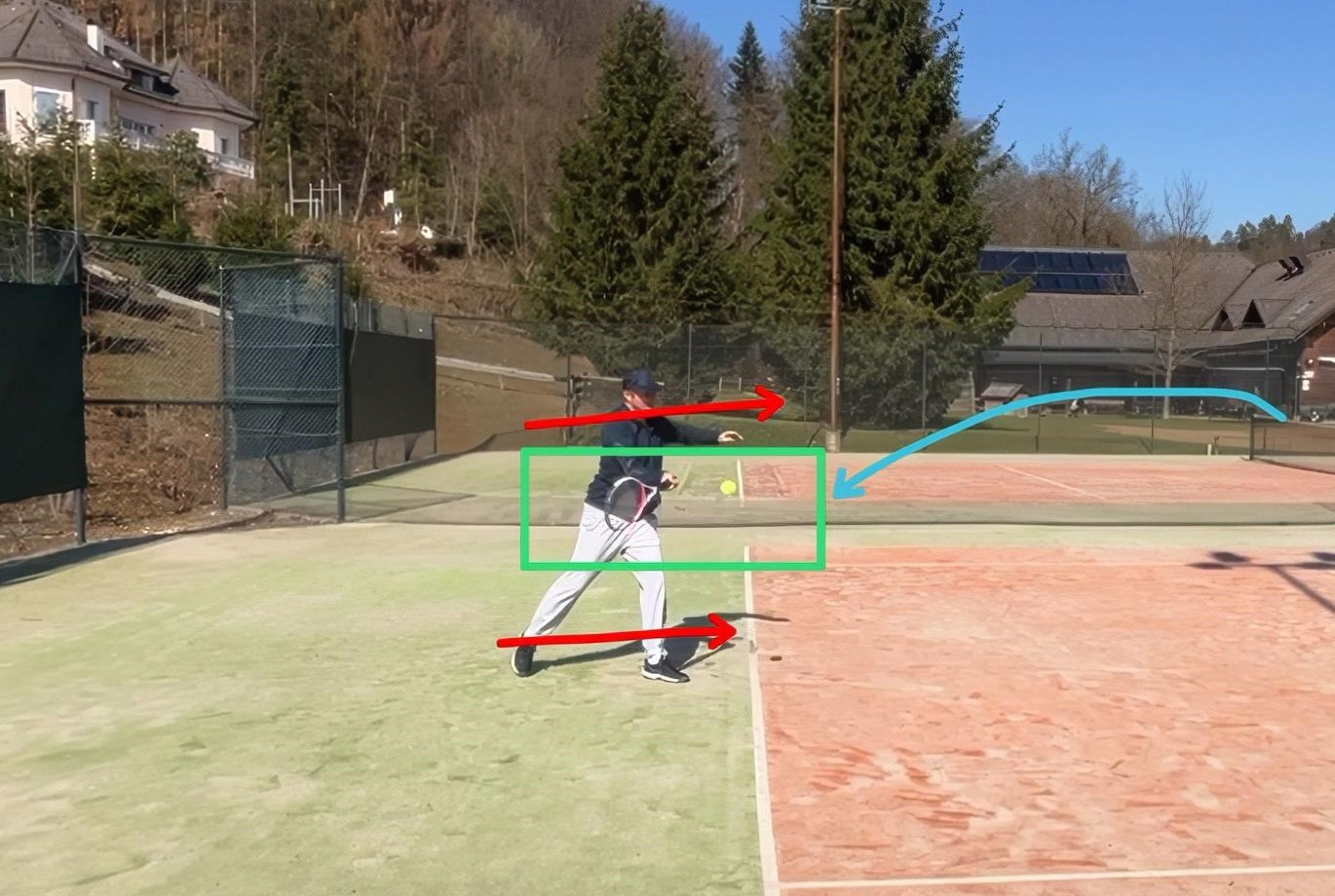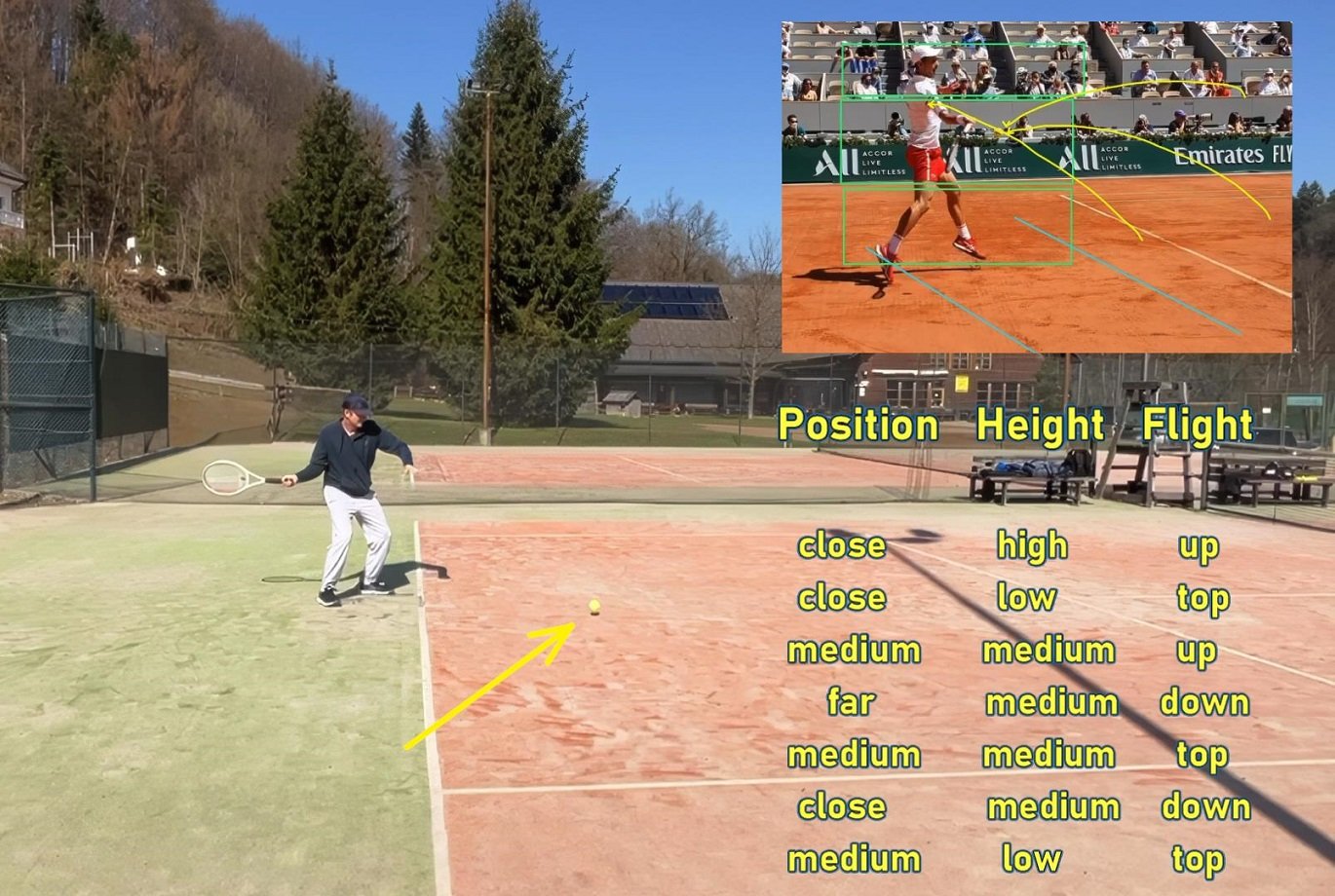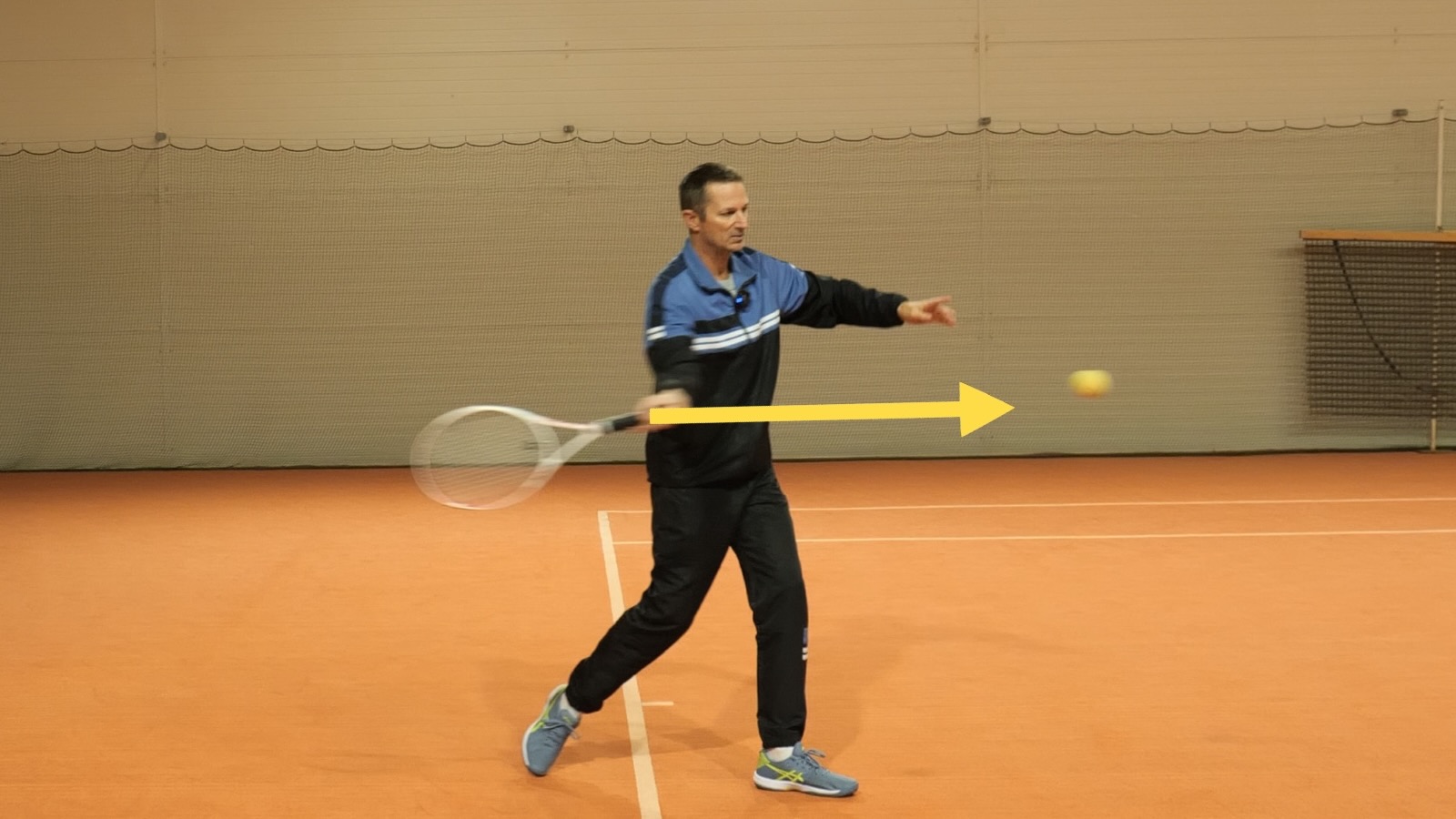Tennis is an open skill sport which means players need to constantly adjust their timing and technique to different incoming balls and different ways they move in relation to that ball.
One mistake that tennis players make is that they tend to repeat (mostly subconsciously) patterns of hitting and movement in order to hit the ball in the way they prefer the most.
The problem with such an approach is that they don't get enough practice with the other types of balls at different heights, different times from the bounce, and different trajectories that will inevitably happen in the match.

If you always want to hit the ball at low contact point, you will miss out on practicing hitting higher contacts...
Once they have to hit in a situation that they haven't practiced enough and are not comfortable with, there's a high likelihood that they will miss or hit a poor shot.
In this article, you'll learn how you can use a certain type of baseline movement and positioning in tennis that will challenge you to practice most of the types of incoming balls that you will encounter in a match.
Understanding Variations In Hitting A Tennis Ball
To better explain most of the variations a tennis player has to deal with in a tennis match we'll use an example of Novak Djokovic playing one point at Roland Garros 2022.
Special thanks to the Inside the Game YouTube channel for letting me use the footage and images from their video clip.
The video above should start with the point we analyzed in this video article.
While there are many variables in relation to a tennis ball that we need to adapt to in a match, we'll focus on three major ones in this example:
- position of the player in relation to the baseline (close, medium, or far)
- contact point height (low, medium, or high)
- trajectory of the ball at contact (on the way down, on top of the bounce, or on the way up)
If you've watched the video above, then you have seen Novak hit the ball in many different situations; in fact, of the seven shots he played in that one point, he never hit the ball in the same situation twice. 😉

We're analyzing only 3 parameters of each tennis stroke but there are many more...
With just three different variables each having three different categories, we can already see that there are 3x3 = 9 combinations possible.
This, of course, doesn't take into account the speed, spin, direction, and time from the bounce of the ball.
It also does not take into account the type of shot Novak decided to play off each incoming ball, as he varied the speed, height, spin, speed, and direction of his own shots.
So, the main takeaway from this first part of the article is that we need to able to adapt to many different types of incoming balls and hit them well at different contact point heights, distances from the baseline, and flight trajectories.
The 3 Most Common Mistakes In Movement And Positioning
Now that you're aware of how challenging the game of tennis is, see if you can spot yourself in one of the examples of common mistakes players make when it comes to their movement and positioning on the baseline.
a) Always Stepping In
In my work with adult recreational tennis players, I see this pattern the most.
I don't blame the players. Instead, I blame the coaching community who have over-simplified the complexity of tennis and brainwashed tennis players into believing that stepping into the ball, transferring weight into it, and taking it early is the best way to hit.
What they fail to tell you is that this way of hitting the ball is very risky and that one needs to carefully decide on which type of the incoming ball is stepping in really worth the risk or necessary if the ball is really short.
They also don't know (as they don't practice) how to hit an open stance forehand well, so if it does happen, it's executed poorly and the ball usually ends up in the net or short.
If we now look at this movement pattern from the point of view of many variations that happen in a tennis match, we see that the player who constantly steps into the ball limits themselves to generally just medium contact point height and hits most balls on the rise or on top of the bounce.

Players who always step into the ball hit only at a certain height with a certain trajectory...
Again, if you've been told a million times that this is the best way to hit the ball, then the above description sounds great to you.
But if you remember what Novak Djokovic had to deal with in just one point and extrapolate that to the whole match, you'll see that one also needs to be able to cleanly hit balls that come into the high and low contact zones, far behind the baseline, and often in a downward trajectory.

You're missing out on practicing high and low contact points and other ball trajectories.
To give you a simple table to show what the player hits most of the time and what they miss out on:
HIT MOST: position: close, contact height: medium, flight: up and top
MISSING OUT ON: position: medium and far, contact point: high and low, flight: down
b) Always Moving Backwards
Many tennis players tend to move backwards all the time so they can gain more time from the bounce of the ball and hit the ball at a low contact point, which feels very comfortable to them.
In addition to missing out on practicing the other variations of hitting the ball, they also tire themselves out because of the constant movement.
They have almost no chance to apply pressure on the opponent, as they are hitting the ball so far behind the baseline.

If you're always hitting at low contact point you miss out on many other variations of the stroke.
So, not only do they play a lot of long points, but they also wear themselves out with constant forward and backward movement.
This raises the questions: what do they mostly hit, and what do they miss out on?
HIT MOST: position: far, contact height: low, flight: down
MISSING OUT ON: position: medium and close, contact height: medium and high, flight: top and up
c) Crowding/Hugging The Baseline
This type of player is similar to the first one, but they don't always step into the ball. They are also able to play open stance.
They stand very close to the baseline, taking all the balls very early, and they make no forward or backward adjustments to the ball. Instead, they only move sideways parallel to the baseline.
The problem with this type of playing is again a very high risk of mis-hitting the ball.

Player stays close to the baseline not reading and adjusting to the ball's trajectory.
There is a very short amount of time from the bounce of the ball to the contact, and it's very likely that the player will hit the ball late and off center, which results in short balls and missed shots.
So, what types of shots do these players hit the most, and what do they miss out on?
HIT MOST: position: close, contact height: medium, flight: up
MISSING OUT ON: position: medium and far, contact point: low and high, flight: top and down
I'd like to quickly mention the fourth incorrect way of positioning, which is to stand very far from the baseline and wait for all the balls to reach you.
This is not a common type of baseline positioning because the player is vulnerable to short balls.
As a result, only players who have really good ball judgment skills and are quick on their feet can afford to spend most of their time far behind the baseline.
The majority of adult recreational tennis players do not fall into this category, so I see this pattern rarely.
Since you're now much more knowledgeable about the variations in tennis, you can already see what this type of player would be missing out on playing like that.
Holding Your Ground And Challenging Your Timing
So, what is the best way to position and move when playing from the baseline in free hitting sessions?
The best way is to position yourself at a medium distance from the baseline and make small adjustments forward and backward when necessary.

I move mostly inside the yellow lines area and I do smaller forward & backward adjustments.
My typical “home base” position is about 1.5 meters (5 feet) behind the baseline.
If I mostly move around this distance from the baseline and make 0.5 meter (2 foot) adjustments forward and backward when necessary, I will hit all of the major variations in terms of contact point height and trajectory.
In other words, I will hit at high, medium, and low contact points, and at the same time the incoming balls' trajectories will include balls on the way up, on top of the bounce, and on the way down.

It just so happened that in just 3 incoming balls I hit three different height forehands – because I held my ground...
While I will be hitting mostly at the medium distance to the baseline and I will vary that parameter the least, I will still move out of my zone here and there to play the ball close and also far from the baseline.
We obviously cannot practice all the elements and variations of a tennis game in one single approach, but what I mostly want to challenge myself with the Hold the Ground concept is to hit balls at different heights, flight times from the bounce, and trajectories.
When a player keeps repeating one of the above three incorrect patterns of positioning and movement on the baseline, they are basically making themselves comfortable in hitting one pattern of timing.
When I decide to hold my ground, I intentionally challenge myself NOT TO MAKE the same adjustments to the incoming balls so that I hit many balls at different heights, times from the bounce, and trajectories.
Players who keep stepping in and crowd the baseline don't know how to wait for the ball and give themselves more time, while players who keep moving backward don't know how to hit the ball early.

Just a reminder of how many variations you have to deal with if you track only 3 parameters...
By playing at the medium distance from the baseline and not constantly adjusting your position and movement to the ball, you can challenge yourself to adjust to the ball by hitting it with different timings, heights, and trajectories – and that's what will actually improve your general skill of playing tennis well.
Having weaknesses in your game means more than having a “weak backhand.”
It can also mean “not being able to hit a forehand at a high contact point” or “not being good at hitting the ball at a low contact point with a downward trajectory.”
Your opponent can exploit any of these weaknesses and win the match.
A skilled tennis player is a player who can handle all the variations of contact point heights, ball trajectories, and distances from the baseline well – which means they mostly hit the ball well in front and into the sweet spot, giving them good power and control at the same time.
Since tennis is such a demanding sport where we have to deal with so many different situations, we need to practice them as much as we can.
Hold your ground the next time you have a free hitting session. Intentionally challenge yourself to hit balls that you're not comfortable with and give it some time.
If you regularly do that, you will see improvements in your timing and ability to hit the ball cleanly. Then you'll realize a simple fact: you're now a better tennis player.





Hi Tomaz,
Nice video; I love it when you explain about the open skill character of our sport (the artikel you wrote long ago about the technique myth is probably the best article I ever read about tennis)!:)
I can see a whole series of videos on this topic.
It’s a nice base to learn to make little adjustments in just rallying through the middle from medium positition.
I would love to see videos from you going deeper on this topic:
* Drills: for example one player plays with variation (high spin, low slice, fast and deep, etc.) and the other player has to adjust and neutralise.
* Reading/anticipation: it’s nice to adjust from the medium position, but good players read the situation and see/feel in which zone/position the should recover (maybe some ideas to train this).
* Focus points: I think the reason a lot of players get stuck in one pattern is because they learn to focus on the wrong things; internally, explicit and situational instead of externally, implicit and fundamental.
instead of learning footwork patterns for example (which are internal, explicit and situational) I prefer to let players focus on beat the bounce (preparing on time), make clear contact in the hitting zone and recover on time. All the footwork patterns develop implicitly then (when the learn this way from the start) while adapting for the situation and keeping the focus externally (in the game instead of on the body).
Well, I’m looking forward to your view on this and hope I challenge you to go deeper on this nice video you made:)
All the best,
Paul Honig
Hey Paul,
Thanks for the all the info and feedback!
Re: drills for variation: yes, for higher level junior players if they have good enough ball control to actually vary the strokes so accurately that the other player can work on variations.
But inevitably these variations just happen in free hitting sessions. I have been playing like this for over 25 years and I get to hit all the types of incoming balls mentioned here.
Re: Anticipation – yes, I have this topic for long time in my notes. Will do something in the future. The first simple guideline is that you want to maintain roughly the same distance from your opponent at all times.
If you manage to push them back, move closer to baseline. If you hit short and they start moving in, move backwards to buy time – just like Novak did after his third shot in the point analyzed above.
Re: Implicit footwork learning – yes, but in my experience (and it is also reality, I am very sure), only juniors will develop footwork implicitly and only if they keep attending conditioning outside of tennis lessons or get involved with other sports with lots of movement like basketball, football, volleyball, etc.
Adult recreational players DO NOT learn footwork implicitly. They are stuck with their patterns of movement and cannot get out of them even if they play 20 years.
You need to teach them the patterns and most are completely foreign to them and take long time to automate and become more fluid.
It comes down to natural coordination which develops at early age and then the window of opportunity starts to close somewhere at around 16 years old and the learning slows down.
So with juniors I am all for not teaching them footwork so much with ladders and cones but have them play some basketball, soccer and other sports and they will develop those skills and also have way more fun than doing another boring round of training.
Hi Tomaz.
Tennis is an open skill. Yes, it is. As always, you explore things from a different point of view, and indeed those are what we need. I will implement these in our practice sessions. I have 3 children 17 yo, 11 yo, and 8 yo. My second one tends to move backward, and my youngest one tends to take the ball early most of the time. Keep your distance from your opponent roughly the same, a necessary clue for movement.
Thank you so much.
syerli
Hey Syerli, yes, we need to push players outside of their comfort zone in training session so that eventually they are comfortable in all situations. 😉
One other thing to look for is that most players are more comfortable hitting forehands so as they warm up they will tend to move around the backhand to hit more forehands.
We as coaches must spot that and make sure that they hit at least 50:50 forehand / backhand ratio or sometimes focus more on the weaker shot so that it can eventually catch up with the better one or at least come closer to it.
Great in dept analysis, as always.
Thanks.
Hi Tomas! Once again i can tell you are the best coach I ever know, as in tennis lessons online as in your Tennis Strategy Encyclopedia, book I read fifth times since now!
About this topic: Optimal Tennis Baseline Position And Movement, I’d like to know something about these variations in a match: how a player chose one on one other? In other words, why he looks for a more high/medium/low ball – on the rise/fall ?? (I suppose there are tactical reason). Can he choose it on every shot, or sometimes he can do it just a little?
All the best!
Salvatore
P.S. This summer I come to Slovenia, it’s such a beautiful conutry, with very friendly people. My entire family now loves it!